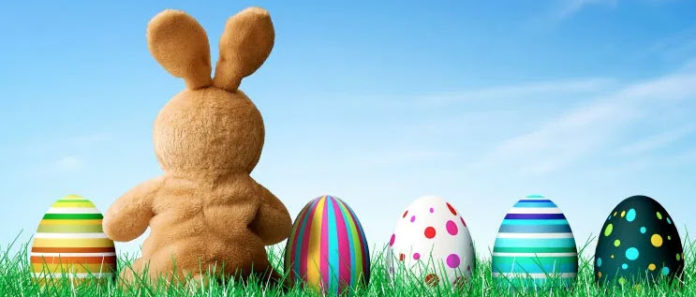By TR Robertson
March & April are months of celebration as they incorporate everything from St. Patrick’s Day to the Eastern Orthodox beginnings of Lent, to the start of the Christian Holy Week celebrating the resurrection of Jesus Christ. That week begins with Palm Sunday, followed by Passover on Thursday, Good Friday and Resurrection Sunday, this year celebrated on April 17th. We now refer to Resurrection Sunday as Easter Sunday even though the name Easter comes from a Teutonic Anglo-Saxon pagan goddess of spring named Eostre. This goddess was the goddess of rebirth and renewal and a rabbit was her symbol. The story goes that Eostre found a bird dying from the cold and she turned it into a rabbit with fur to keep warm. The rabbit was allowed to still lay eggs like a bird and would decorate the eggs to show his loyalty to Eostre. Regardless of your religious affiliation, Easter has grown into a holiday celebration filled with interesting facts and trivia. Here are a few of the historical facts, trivia and folklore around this holiday.
• Easter was once known as Egg Sunday in Western Europe, a day to eat eggs.
• White lilies became the flower of Easter as the petals faced downward in a symbolic honor to Jesus.
• The tradition of wearing a new piece of clothing on Easter Sunday began to bring good luck for the year. Initially, the bonnet was the new piece of clothing purchased by women.
• The tradition of Easter sunrise service began in 1732 in Saxony, Germany.
• The first sunrise service in the United States was held in 1773min Winston-Salem, North Carolina.
• The song “Easter Parade” was written by Irving Berlin in 1933 and sung by Bing Crosby in the 1942 movie “Holiday Inn”.
• The tradition of decorated eggs may stretch back to the ancient pagans, symbolizing rebirth and life.
• The tradition of Easter baskets comes from Germany where children would build nests to keep the eggs, today thousands of baskets are sold to do this.
• In 19th century German pastry and sugar bunnies at Easter had hard boiled eggs inside of them.
• The first egg hunt can be dated back to Martin Luther and the Protestant Reformation.
• The eggs were originally dyed red, representing Christ’s blood, to protect the Children from bad luck.
• Colored eggs were exchanged long ago as a symbol of rebirth as part of a springtime custom.
• Hard boiled eggs became popular because Christians that fasted during Lent were prohibited from eating eggs, boiling them allowed the eggs to last until after Lent.
• The most expensive eggs in the world are the jeweled Faberge eggs called the Tsar Imperial Easter eggs and the Jeweled Hen eggs. 54 of these Faberge eggs were made for Tsar Alexander III and presented to him in 1885.
• The Easter egg roll on the White House Lawn began in 1878 during President Rutherford B. Hayes’s term.
• The largest chocolate Easter egg ever made is from France and stands 25 feet tall and weighs 8,568 pounds and is held in place by a large steel frame.
• Chocolate eggs were first made in the 1800’s in Germany.
• Reese’s now makes a Peanut Butter egg.
• The Bourneville Factory in Birmingham, UK turns out 1.5 million Cadbury eggs per day.
• Cadbury eggs debuted in 1875.
• The game of egg knocking or egg tapping or egg jarping began in Medieval Europe. Two competitors tap the pointed end of the eggs to see which one cracks first.
• Since 1956, the people of Marksville, Louisiana, have an Easter Sunday egg battle.
• Hot cross buns were originally made by 12th century monks in England and were passed out to the poor. The crosses were made on the buns using a jelly.
• In Medieval England, bakers could not sell spice breads except on special holidays.
• In the Middle Ages, it was believed that baking bread on Good Friday would allow the bread to never go moldy. If they kept the bread for 1 year it would ward off fires, keep rats off the grain and protect ships from becoming shipwrecked.
• In the Middle Ages, if you did laundry on Good Friday you would have bad luck for that year.
• Some European countries still have large bonfires on Easter Eve and burn effigies of Judas Iscariot.
• The tradition of the Easter bunny laying eggs for children to find on Easter began in Germany.
• In Australia, rabbits are considered a nuisance. They use the bilby or bandicoot, a desert dwelling marsupial, as their “Easter bunny”.
• In Germany the celebration of Osterbrunnen involves decorating public wells and fountains with elaborate greenery and Easter egg décor.
• The city of Frankenmuth, Michigan, celebrates Osterbrunnen.
• The song “Here Comes Peter Cottontail” was made famous by cowboy singer/star Gene Autry.
• 90 million chocolate bunnies are sold each year.
• R.M. Palmer Company is said to have made the first chocolate bunnies and they made them hollow to make them easier to eat.
• 76% of all Americans who purchase a chocolate bunny will eat the ears first.
• Solid chocolate bunnies are preferred over hollow ones.
• 7.1 billion pounds of chocolate will be sold this Easter.
• 700 million Peeps will be sold at Easter. They were first introduced in 1953.
• Peeps now come in a range of colors but yellow is the most popular.
• Over 16 billion jelly beans will be available at Easter. This is enough to circle the Earth 3 time.
• Jelly beans were first introduced for Easter in the 1930’s.
• Jelly beans first appeared in 1861, made by Boston candy maker William Schrafft. He urged people to send them to loved ones fighting in the Civil War.
• 70% of people who eat jelly beans will eat them 1 at a time to savor the individual flavor.
• Red jelly beans are kids favorite.
• Between 1910-1920, jellybean was a term for a man who dressed sharp to attract women, but who had no other credentials making him marriageable material.
• Pretzels were once an Easter treat, the twist meant to resemble arms crossed in prayer.
• 75% of all children say they are willing to do more chores if they get more Easter candy.
• In the U.S., 88% of parents decorate and hide Easter baskets and eggs for their kids.
• In the 1870’s, the first Easter parades were held in the United States in New York City.
• The most common Easter greeting card sold has egg designs on them, according to Hallmark.
• Americans will spend on the average $2 billion on Easter candy.
• Easter is second only to Halloween in candy sales.
• Lamb is the traditional Easter meat served at meals. It was believed that if meat was served at Jesus’s Last Supper, it would have been lamb.
• Eating ham dates back to 6th century Germany.
• Traditional lunches or dinners served on Easter Sunday will feature ham, lamb or chicken. Easter Sunday brunch has become a highlight for many restaurants.
• Most homes will serve various baked goods on Easter Sunday. Hot cross buns from the UK and coffee cake are very popular.
• Other traditional foods served from around the world at Easter include Paska and Kulich cake from Russia, Colombadi Pasqua from Italy, Tsoureki from Greece, Mona de Paseua and Rosqullas from Spain, Capirotada from Mexico, Pococa de Amendoim from Brazil and Mammi from Finland. Look some of these foods up for interesting additions to your Easter lunch or dinner.
• In Germany, a tradition of serving green colored food on Thursday of Holy Week is shown with the serving of the popular Chervil soup.
• In the British island territory of Bermuda an Easter tradition of kite-flying happens on Good Friday at Horseshoe Bay Beach at the Kite Festival.
• In Bessieres, France, the townspeople have an Easter tradition of making a huge 14 ft. omelet, using 15,000 eggs.
• In Florence, Italy, a huge elaborate Easter cart is built filled with fireworks. The cart is pulled in front of the Duomo Cathedral, where the Archbishop of Florence lights the fuse during the Easter mass. This 350 year old tradition is to ensure a good harvest.
However you celebrate Easter or Easter week, be safe, have fun, don’t eat too much chocolate and enjoy the time with your families.
Array
The Traditions and Trivia of Easter
SourceTR Robertson
RELATED ARTICLES



